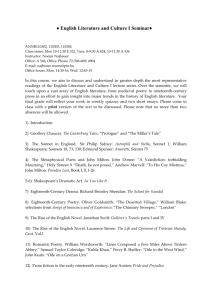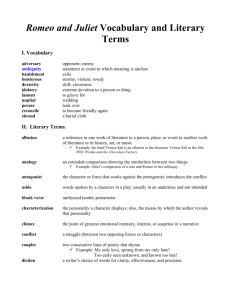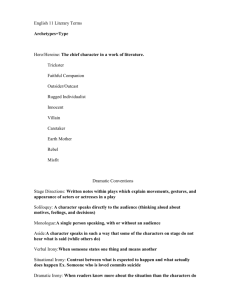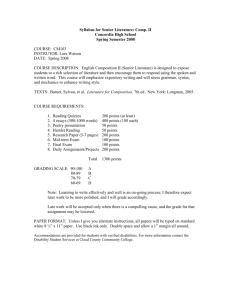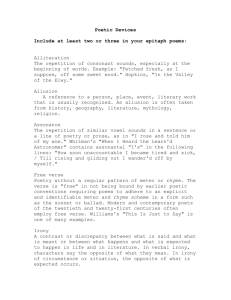File - Mr. Nurre's English Courses
advertisement
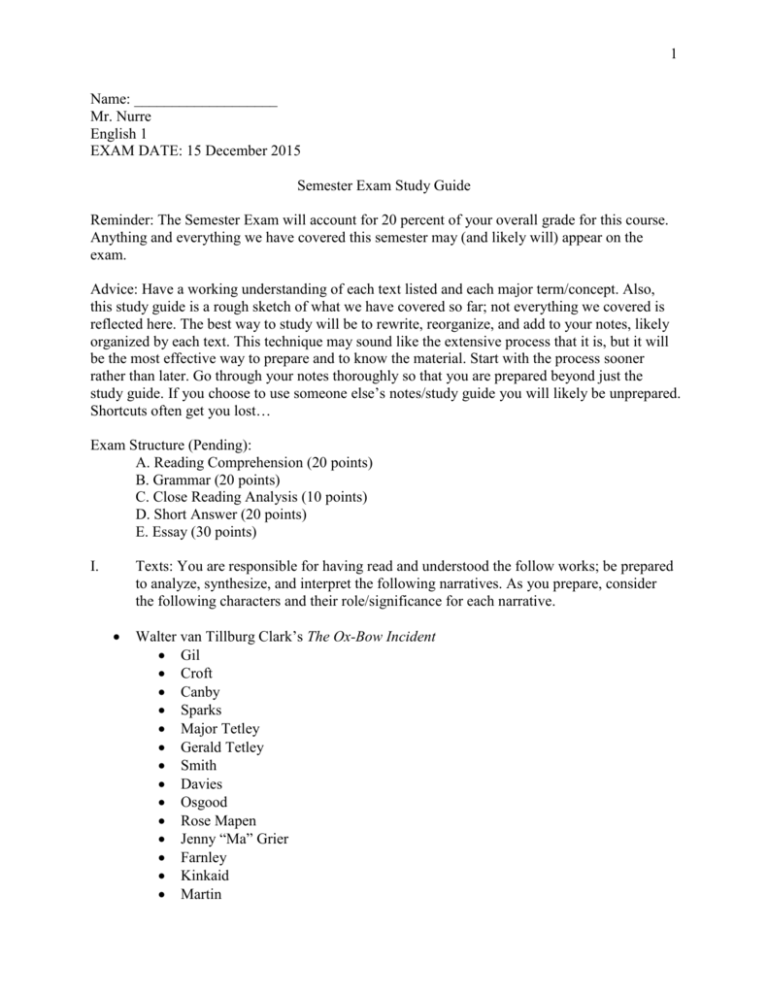
1 Name: ___________________ Mr. Nurre English 1 EXAM DATE: 15 December 2015 Semester Exam Study Guide Reminder: The Semester Exam will account for 20 percent of your overall grade for this course. Anything and everything we have covered this semester may (and likely will) appear on the exam. Advice: Have a working understanding of each text listed and each major term/concept. Also, this study guide is a rough sketch of what we have covered so far; not everything we covered is reflected here. The best way to study will be to rewrite, reorganize, and add to your notes, likely organized by each text. This technique may sound like the extensive process that it is, but it will be the most effective way to prepare and to know the material. Start with the process sooner rather than later. Go through your notes thoroughly so that you are prepared beyond just the study guide. If you choose to use someone else’s notes/study guide you will likely be unprepared. Shortcuts often get you lost… Exam Structure (Pending): A. Reading Comprehension (20 points) B. Grammar (20 points) C. Close Reading Analysis (10 points) D. Short Answer (20 points) E. Essay (30 points) I. Texts: You are responsible for having read and understood the follow works; be prepared to analyze, synthesize, and interpret the following narratives. As you prepare, consider the following characters and their role/significance for each narrative. Walter van Tillburg Clark’s The Ox-Bow Incident Gil Croft Canby Sparks Major Tetley Gerald Tetley Smith Davies Osgood Rose Mapen Jenny “Ma” Grier Farnley Kinkaid Martin 2 Edgar Rice Burroughs: “Tarzan of the Apes” Tarzan Jane Terkoz The Gorilla Tribe William Faulkner: “A Rose for Emily” Miss Emily Grierson Colonel Sartoris The Townsfolk (especially male leaders) Homer Barron Tobe, the Negro Servant The Pharmacist Herman Melville: “Bartleby, the Scrivener: A Story of Wall Street” Narrator Turkey Nippers Ginger Nut Bartleby Ernest Hemingway: “Soldier’s Home Harold Krebs Krebs’ Mother Krebs’ Father Krebs’ Sister The Girls of the Town The European Women Graham Greene’s “The Destructors” T (Trevor) Blackie Mike Mr. Thomas/Old Misery The Man in the Carpark Doris Lessing’s “A Sunrise on the Veld” The Boy The Buck The Ants Ovid’s Metamorphoses Julius Caesar Ovid 3 Casesar Augustus Four Ages after the First Creation The Flood Jove Lycaon Deucalion Pyrrha Second Creation Apollo Daphne Io Juno Phaethon The Heliades Callisto Arcas The Raven and the Crow Prophecies of Ocyrhoe Mercury Battus Aglauros Minerva Envy Europa Cadmus Thebes Snake of Thebes Actaeon Diana Semele Tiresias Narcissus Echo River Styx Bacchus Pentheus Acoetes Perseus Atlas Andromeda Medusa Medea Jason Aeson Pelias 4 Pelias’ Daughters Icarus Daedalus Pyramus Thisbe Perdix Hercules Nassus Deinira Lichas Poetry: Billy Collins: "Introduction to Poetry" (356) ee cummings: "1(a" (351) Robert Frost: "Design" (365) Robert Herrick: "To Virgins, to Make Much of Time" (381) Gwendolyn Brooks: "We Real Cool" (393) Joan Murray: "We Old Dudes" (393) William Carlos Williams: "Poem" (398) Amy Lowell: "The Pond" (404) Ezra Pound: “In the Station of a Metro” (in class) Stephen Crane: "A Man Said to the Universe" (438) Bill Hicock: "Making it in poetry" (438-9) Kevin Pierce: "Proof of Origin" (439) William Blake: "The Chimney Sweeper" (448-9) Lewis Carroll: "Jabberwocky" (461) Helen Chasin: "The Word Plum” (467) John Maloney: "Good!" (477) Theodore Roethke: “My Papa’s Waltz” (in class) William Shakespeare: "Shall I compare thee to a summer's day?" (492) Sherman Alexie: "The Facebook Sonnet" (495) Walt Whitman: "When I Heard the Learn’d Astronomer" (511-12) Richard Hague: "Directions for Resisting the SAT" (513) Elizabeth Bishop: “The Fish” (in class) II. Major Terms and Ideas: Consider these major terms and ideas and the way they appear in the stories we have read and discussed. Be prepared to discuss these ideas in short answer and essay questions; be prepared to compare multiple stories based on the ways they deal with one or more of these concepts. Gender: The Role of Women and Men Class Critiques Social/Cultural Critiques Narrative Structure: Exposition, Major Conflict, Rising Action, Climax, Falling Action/Moral Fallout Elements of Fiction: Plot, Character, Setting, Symbolism, Theme Dynamic and Static Characters Protagonist 5 Antagonist Cultural Values: Greek, Roman, American Cultural Ideals v. Cultural Realities Language and Narrative: Narrative Style and Presentation o 1st Person o 2nd Person o 3rd Person o Reliable Narrator/Narration Epic Poetry Colonialism/Colonization Capital/Commodity Trauma Shame Social and/or Personal Ethics Hypocrisy Violence/Brutality Perspective: Subjective v. Objective Role of Nature Role of Supernatural Leadership Foreshadowing Microcosm Fate Autonomy Identity Fault/Shame Martyrdom Catharsis Feminine Ideal (Roman, Greek, American) Masculine Ideal (Roman, Greek, American) Progress: Social and/or Individual Maturation Struggle/Obstacles Importance of Experience Metamorphoses Epic Poem (and its 5 components) Invocation Muses in medias res Epithets Catalogues/enumeratio The Speech The Intervention of Gods The Hero-Community Dynamic Myth 6 Allusion Patricians/Plebians Proem Morality/Ethics and Behavior, Thoughts, Action/(In)action; Dynamism/Staticity Destruction Creation Consequence God-Human Relations Reliance on the Supernatural Social Tensions Cultural Values Honor Hubris Humility Hero Accident/Happenstance Fault Father-Son (or Parent-Child) Relationships Grief Emotion/Affect Irrationality Impulse Guilt Archetype Victimization Guile Violence Poetry: o Narrative o o o o o o o o o o o o o o o o o Theme Metaphor Symbol Speaker/Narrator Voice Diction Denotation Connotation Syntax Tone Mood Allusion Image Imagery Sensory Details Symbol Allegory 7 o o o o o o o o o o o o o o o o o o o o o o o o o o o o o o o o o o o o o o Didactic/Polemical Poetry Irony Situational Irony Verbal Irony Satire Dramatic Irony Cosmic Irony Onomatopoeia Alliteration Assonance Consonance Euphony Cacophony Rhyme End Rhyme Internal Rhyme Exact Rhyme Approximate Rhyme Rhythm Stress/Accent Meter Line Enjambment Form Fixed Form Stanza Rhyme Scheme Couplet Heroic Couplet Tercet Triplet Quatrain Sonnet Italian/Petrarchan Sonnet English/Shakespearean Sonnet Elegy Ode Free Verse/Open Form 8 III. Grammar: You are responsible for understanding the definition of the following terms. For grammar, you must also understand the function of the concept—namely how to identify it in a sentence. Study by review old homework and additional exercises. This section of the exam will be multiple choice. Chapter 12: Parts of Speech o Nouns (common and proper) o Pronouns: Demonstrative, Personal, Relative o Antecedents o Adjectives o Verbs o Adverbs o Prepositions o Conjunctions o Expletives Chapter 13: Parts of a Sentence o Fragment o Subject o Predicate o Complements o Predicate Nominative o Predicate Adjective o Direct Object o Indirect Object





